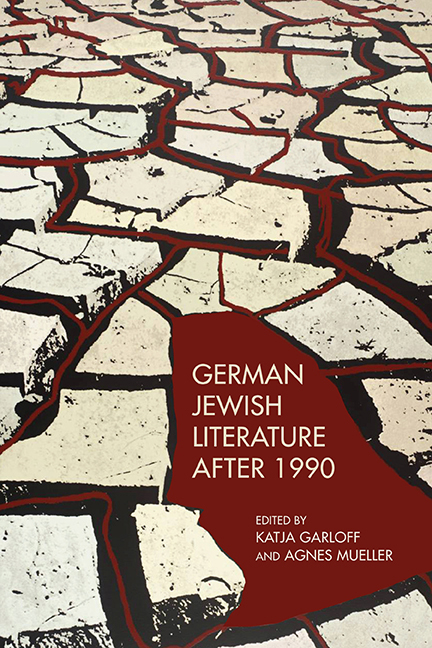Book contents
- Frontmatter
- Contents
- Acknowledgments
- Introduction
- I Self-Reflection in First- and Second-Generation Authors
- II Multiple Identities and Diversification of Holocaust Memory
- 4 The German Jewish Migrant Novel after 1990: Politics of Memory and Multidirectional Writing
- 5 Beyond Negative Symbiosis: The Displacement of Holocaust Trauma and Memory in Alina Bronksy's Scherbenpark and Olga Grjasnowa's Der Russe ist einer, der Birken liebt
- 6 Memory without Borders? Migrant Identity and the Legacy of the Holocaust in Olga Grjasnowa's Der Russe ist einer, der Birken liebt
- 7 Multilingualism and Jewishness in Katja Petrowskaja's Vielleicht Esther
- III New Themes and Directions in Recent German Jewish Literature
- IV Coda: Interviews with Two Contemporary German Jewish Writers
- Bibliography
- Notes on the Contributors
- Index
7 - Multilingualism and Jewishness in Katja Petrowskaja's Vielleicht Esther
from II - Multiple Identities and Diversification of Holocaust Memory
Published online by Cambridge University Press: 07 September 2018
- Frontmatter
- Contents
- Acknowledgments
- Introduction
- I Self-Reflection in First- and Second-Generation Authors
- II Multiple Identities and Diversification of Holocaust Memory
- 4 The German Jewish Migrant Novel after 1990: Politics of Memory and Multidirectional Writing
- 5 Beyond Negative Symbiosis: The Displacement of Holocaust Trauma and Memory in Alina Bronksy's Scherbenpark and Olga Grjasnowa's Der Russe ist einer, der Birken liebt
- 6 Memory without Borders? Migrant Identity and the Legacy of the Holocaust in Olga Grjasnowa's Der Russe ist einer, der Birken liebt
- 7 Multilingualism and Jewishness in Katja Petrowskaja's Vielleicht Esther
- III New Themes and Directions in Recent German Jewish Literature
- IV Coda: Interviews with Two Contemporary German Jewish Writers
- Bibliography
- Notes on the Contributors
- Index
Summary
Newer Forms of Jewish Writing in German and Katja Petrowskaja
SINCE THE EMERGENCE of the German Jewish literature of the so-called second generation after the Holocaust in the late 1980s and early 1990s, the field of Jewish writing in German has greatly diversified. To be sure, the second-generation authors, including Irene Dische, Rafael Seligmann, Chaim Noll, Barbara Honigmann, Esther Dischereit, Robert Schindel, and Doron Rabinovici, were never a homogeneous group. Scholars such as Hartmut Steinecke, Andreas B. Kilcher, Karen Remmler, and others have stressed that their writing represents “a diverse chorus of individuals” that constitutes what Kilcher has called the “irreduzibel vieldeutige[n] interkulturelle[n] Raum der deutsch-jüdischen Literatur” (irreducibly ambiguous intercultural space of German Jewish literature). However, at least two characteristics were widely perceived as typical for these authors who spoke as Jews in Germany (and Austria), and to German (and Austrian) audiences. First, as German-speaking writers they either continued, or explicitly refused to continue, the pre-Holocaust German Jewish culture that remained a crucial point of orientation. Consciously or unconsciously, most of the authors established connections to this culture through intertextuality and genealogy, and they worked through a “lost or repressed Jewish identity” and literary traditions associated with Jewish existence in Germany. Secondly, as European Jews, they were understood and understood themselves as direct or indirect survivors of the Holocaust. The genocide of the Jews and its commemoration by contemporary Germans or Austrians were important themes in many of their stories. As Karen Remmler states, writing in the 1980s and 1990s also meant responding “not only to the destruction wrought by the Nazis against Jews but also to present-day anti-Semitism, real physical danger, and the continual reminders that Germans and Jews are bound by history.” As Doron Rabinovici puts it: “Der Jude ist ein Überlebender, und spricht, ist beredtes Sinnbild, bevor er noch zu reden begonnen hat, wovon die anderen schweigen wollen.” (The Jew is a survivor, he speaks, and represents, even before he begins to talk, what others remain silent about.)
However, considering an even younger generation of Jewish authors today, including Vladimir Vertlib, Wladimir Kaminer, Lena Gorelik, Olga Grjasnowa, and Katja Petrowskaja, one comes to realize that the aforementioned two characteristics do not apply anymore, or at least not entirely.
- Type
- Chapter
- Information
- German Jewish Literature after 1990 , pp. 146 - 166Publisher: Boydell & BrewerPrint publication year: 2018
- 1
- Cited by

